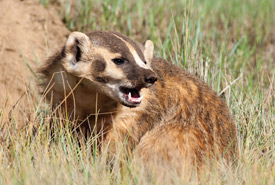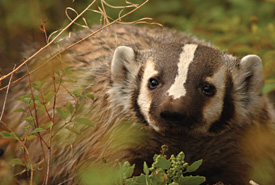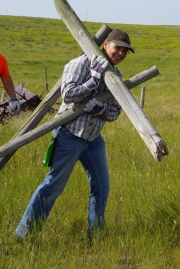The void of indifference

American badger near its burrow (Photo by Gerald A. DeBoer/Shutterstock)
I often take forays out to wilderness areas for what I call it my sanity break. So it was one August afternoon, as I turned my vehicle down a gravel road, that I made an abrupt stop. There, about a quarter of a mile away, I spotted some creature appearing to be rolling around in the middle of the gravel road. What the heck?
Reaching for the binoculars, I took a closer look. It was an American badger! I got so excited. Relatives had shared their experiences of seeing them, but I had never seen one in its natural habitat. I was immediately mesmerized by its squat body, hippy hairstyle and short-legged, rolling gait. It walked pigeon-toed, with his claws prominently displayed.
Although I am sure the badger knew I was there, it kept ambling nonchalantly toward me, seeming to not have a care in the world. I turned on my signal lights to warn other drivers. The badger stopped immediately. Fixated upon the flashing lights, a look of what I interpreted as worry appeared on its face. Fight or flight? I turned the signal lights off and stepped out of the car. The badger resumed its pace, although it shifted to the opposite side of the road.
With each of its steps, my concern about the badger’s “ferocious” nature escalated. When it was within about 50 feet, and betting that its speed to reach me was quicker than my speed to get to safety, I retreated into the vehicle. Dang it! The click of the door caused the badger to meander down into the ditch. The sway of the tall grasses, however, showed that the badger was continuing towards me. My curiosity to see it compelled me to put the vehicle in gear. Having hit the limit of its patience, perhaps, the badger turned off into the thick underbrush.

American badger (Photo by Max Allen/Shutterstock)
As a farm girl, I was raised around animals. I was taught to respect them, in part by giving them their space. Just like the time a porcupine came meandering through my city yard: I respected its space and it mine, and we both walked away better for our shared experience. I believe, unlike our pets, wildlife really does not want to make physical contact with us. As for badgers, research shows that they are only ferocious when cornered or under attack. I can’t argue with that logic. My experiences with animals have left me with a knock or two.
This experience is not of indifference but one of inclusion and hopefully bridges the void of indifference which I too often hear from humans: "It's just an animal."
So, how was it that after almost 60 years of living, this was the first time I had seen a badger? It was breeding season, and this little fella had used a man-made bridge placed there for animals to cross the river. Male badgers have multiple female partners, so it is necessary for them to be able to travel between the females’ territories. The bridge was allowing this to fulfil his life purpose of supporting the health and well-being of his species.
It was more than 10 years ago when I first heard about native wildlife needing our support with wildlife bridges. The Nature Conservancy of Canada (NCC) televised a fundraiser to support the construction of wildlife bridges and corridors over and under Highway 1 here in Alberta’s Rocky Mountains. The fundraiser awakened memories of a childhood spent exploring, discovering and observing my favourite program, The Native Species in my Backyard.
I first started learning about physics, biology, geology and archeology through the “school of life,” sometimes taught by a teacher called “Hard Knocks.” Each experience revealed not only nature’s hidden treasures and secrets, but included life lessons of perseverance, patience, empathy and compassion.
NCC’s engagement programs such as the Conservation Volunteers program help to keep us informed about the challenges facing our native species. At these events, NCC staff share their knowledge about how we may support a healthy, biodiverse ecosystem. For me, however, that this encounter with the badger that reflects a greater truth: our co-dependence. I am grateful to NCC and the American badger for our shared experiences, because together we can build a bridge spanning the void of indifference.


